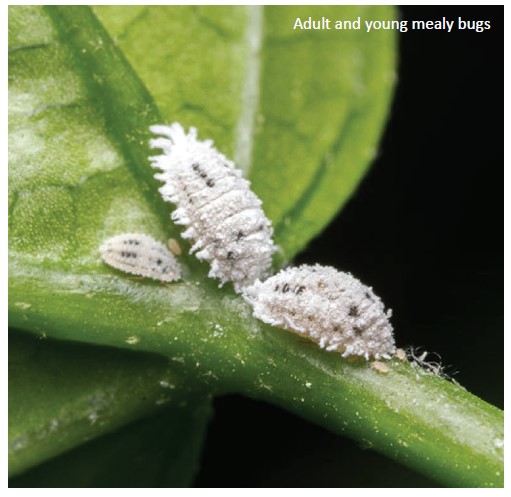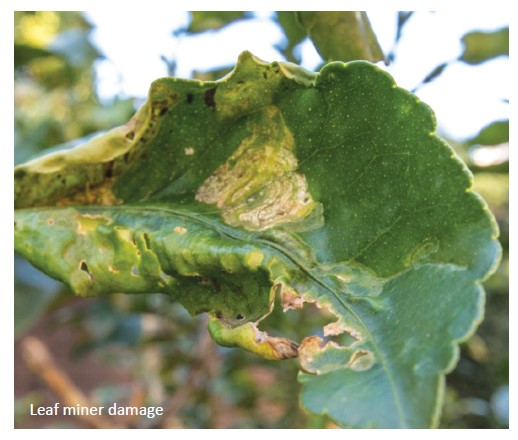By learning diagnostic expertise and management, a gardener will not only be prepared when pests and diseases strike but also prevent their continued occurrence and simplify their control. Easier than it may sound, the process begins with purchasing healthy seeds and plants from a reputable supplier and selecting robust-looking plants, preferably ones that are resistant and/or less susceptible to the more common blights and insects.
Henceforth, stay apprised of the possibility that disease and pests can arrive from an outside source anywhere in the garden, on bedding plants, trees, shrubs, and groundcovers. When problems do arise and pests and disease appear, diagnosing the situation correctly is important in order to determine an effective control procedure.
Some initial questions to answer are: Is the problem located on foliage, stems or roots? Does the condition disfigure, stunt the growth, or kill the plants? Is the disorder the result of insect injury or merely symptomatic of nutrient deficiency?
Combination control is more effective than individual approaches and may dispense with a variety of challenges in a single swoop. Adding a tablespoon of Dawn dish soap to a garden sprayer along with the appropriate pest control products is an example.
Or if your choices of landscape plants include some with recurring nuisances, try planting them in clusters or in close proximity to one another thus affording easier and more precise control.
Consider wise species selection, cultural control, and chemical use (as a last resort) while planning a pest management program to confidently remove the mystery of plant disease control.
 PREDATORY PESTS
PREDATORY PESTS
Attacked by aphids or stricken with snails? Garden pests are generally small to tiny and may have already done extensive damage to your plants before you realize they have taken over your garden.
Proceed with caution however, remembering that it is acceptable to have some bugs that prey on your plants as long as a wide range of the “good guys” that will prey on them are encouraged. Consider control methods only when the bad guys get out of control.
Broad spectrum insecticides are formulated to kill nearly every bug that they come in contact with. They may be toxic to birds, bees and other beneficial insects, and humans.
As a result, they may upset the natural balance between the good and the bad bugs which is critical to maintaining a biodiversity that allows both to coexist in harmony. The first line of defense should be natural management and an ounce of prevention.
Grow healthy and disease-free plants, inspect your plants for signs of distress or damage, deadhead or remove spent blooms and leaves, water appropriately (do not overwater) and keep weeds under control. Attract natural predators to your garden—birds, lizards, frogs, wasps, ladybugs, lacewings, and dragonflies are good examples.
Galveston and the Upper Texas Gulf Coast are especially amenable to the following insects, but this list is certainly not inclusive of all that may be found in any landscape.
Aphids
These tiny soft-bodied insects cluster on leaves, flowers and stems of plants. Aphids may cause distorted, curled or yellowing leaves and malformed blooms. Black sooty mold is often associated with the presence of aphids as they secrete undigested fluid called honeydew. Aphids are extremely prolific and the population increases rapidly in the summer months.
Whiteflies
These tiny white insects are found on the undersides of leaves where both the larvae and the adult insects suck sap from the leaves. The aforementioned problem of sooty mold is also associated with this pest. A sure indication that whiteflies are present is when the plant is moved or shaken; the insects can be seen fluttering rapidly around it.
Slugs and Snails
Both of these cause silvery trails that wind along the plants and leaves. They are mollusks (relatives of oysters and clams) and work mainly at night to protect their soft bodies from the sunlight.
Spider Mites
This type of mite is actually related to spiders. However, they are not beneficial insects but a common garden pest that causes widespread damage while having the advantage of being difficult to spot. About the size of pepper grains, they cause damage by sucking the sap from the undersides of leaves. Place a white paper under a leaf and tap the plant. If specks drop to the paper and begin to crawl around, those are spider mites. Unfortunately, spider mites thrive in hot dry weather such as what we experience during our summer months.
 Leaf Miners
Leaf Miners
Particularly partial to fruit trees, leaf miners leave light colored trails that can be seen through the leaves that eventually curl, dry up and die. Adult leaf miner flies lay their eggs on the leaves; the hatchlings penetrate the leaf to feed on the plant tissue between the inner and outer layer of the leaf.
Mealy Bugs
They appear on stems and leaves as white cottony-looking clusters. The effected leaves may be sticky and covered with black sooty mold from honeydew. The young mealy bugs are fairly mobile and will spread rapidly to nearby plants if not eliminated quickly.
BENEFICIAL BUGS
Beneficial is defined as “promoting a favorable result.” As they work their way around and over plants, they are controlling the infestation of the undesirables.
The beneficial insects listed here will aid in promoting a favorable result in your garden on a daily basis simply by the existence of their voracious appetites.
Ladybugs
One of the most recognizable beneficial insects, ladybugs are fond of aphids, scales, mites, and other soft-bodied insects. A ladybug can eat up to 50 aphids a day and up to 5000 aphids in its lifetime that may be as short as four weeks. Ladybugs are small, oval-shaped winged insects, usually red with black spots or black with red spots.
Assassin Bugs
Known to kill many garden pests including flies, mosquitoes, beetles, and large caterpillars, assassin bugs lie in wait for insects then attack quickly to paralyze their prey, injecting a toxin that dissolves tissue and then sucking up the other bug's tissues. They have an elongated head with a distinct narrow neck and long legs. Most species are dark in color with splashes of brown, red, or orange.
 Dragonflies
Dragonflies
They seek out mosquitoes, gnats, and other flying insects, hovering in mid-air and catching them while flying. The dragonfly has a three-part body—two large eyes that take up most of the head, three pairs of jointed legs, and two pairs of long, delicate, membranous wings.
Prevent pest and disease problems with good gardening practices, and pay close attention to your plants’ needs—healthy soil, water and light requirements, and most importantly, love and attention.
A QUICK START GUIDE
Diseases, Symptoms, Causes, Control
Seedlings decay at the ground line - plants fall over and die; indicates soil fungi from overwatering; apply fungicide
Root and stem rot - plants discolor and die; indicates soil fungi; remove damaged plants and apply fungicide
Marginal leaf burns on leaf edges - points to root failure from excessive fertilizer or overwatering
Leaf blight causes leaves to turn brown or black and wither - may be fungal or bacterial
Leaf spots such as black spots on roses - usually fungal; apply fungicide
Powdery mildew covering leaves - fungal (usually seasonal); apply fungicide
Misshapen or light-colored foliage - virus infection or herbicide chemical